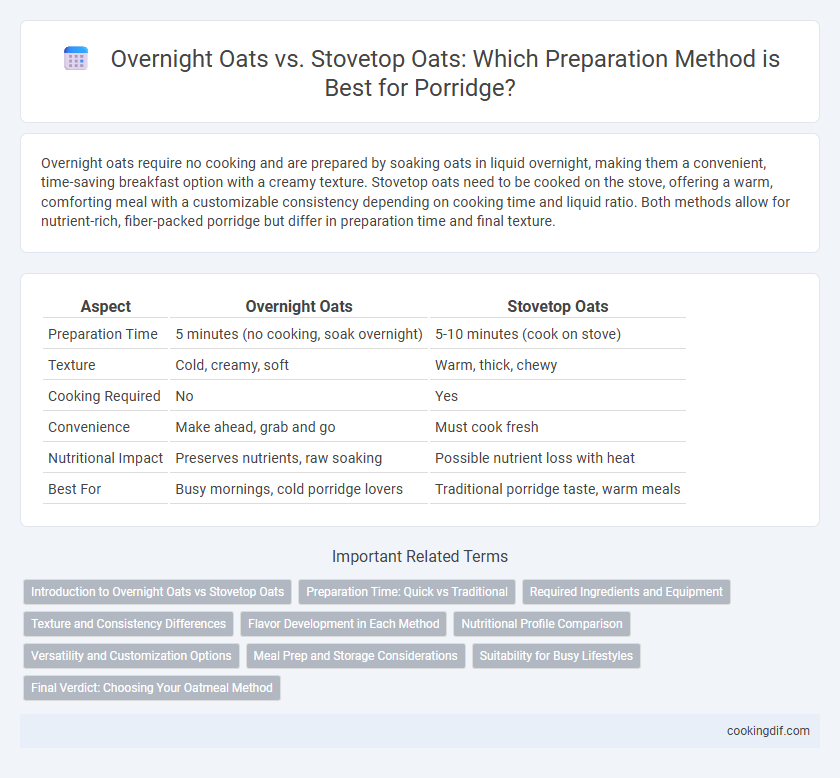Overnight oats require no cooking and are prepared by soaking oats in liquid overnight, making them a convenient, time-saving breakfast option with a creamy texture. Stovetop oats need to be cooked on the stove, offering a warm, comforting meal with a customizable consistency depending on cooking time and liquid ratio. Both methods allow for nutrient-rich, fiber-packed porridge but differ in preparation time and final texture.
Table of Comparison
| Aspect | Overnight Oats | Stovetop Oats |
|---|---|---|
| Preparation Time | 5 minutes (no cooking, soak overnight) | 5-10 minutes (cook on stove) |
| Texture | Cold, creamy, soft | Warm, thick, chewy |
| Cooking Required | No | Yes |
| Convenience | Make ahead, grab and go | Must cook fresh |
| Nutritional Impact | Preserves nutrients, raw soaking | Possible nutrient loss with heat |
| Best For | Busy mornings, cold porridge lovers | Traditional porridge taste, warm meals |
Introduction to Overnight Oats vs Stovetop Oats
Overnight oats require soaking rolled oats in liquid such as milk or yogurt for several hours or overnight, allowing the oats to absorb moisture and soften without cooking. Stovetop oats involve simmering oats with liquid on the stove, resulting in a creamy texture through heat-induced gelatinization. Both methods offer nutrient-rich breakfasts, with overnight oats providing convenience and stovetop oats delivering a warm, freshly cooked option.
Preparation Time: Quick vs Traditional
Overnight oats require minimal preparation time, as they are simply combined and soaked in the refrigerator overnight, making them an ideal quick breakfast option. Stovetop oats need about 5 to 10 minutes of active cooking on the stove, traditionally offering a warm and freshly cooked texture. Choosing between the two depends on whether convenience or traditional warmth is prioritized during morning preparation.
Required Ingredients and Equipment
Overnight oats require minimal ingredients such as rolled oats, milk or yogurt, and optional mix-ins like fruits or nuts, all combined in a jar or container for refrigeration. Stovetop oats demand water or milk, rolled or steel-cut oats, and often a pinch of salt, prepared using a pot and a stove. Equipment needs differ; overnight oats rely on simple containers and a fridge, while stovetop oats necessitate consistent heat and stirring tools.
Texture and Consistency Differences
Overnight oats yield a creamy, smooth texture due to the slow absorption of liquid by the oats, resulting in a softer consistency without the need for cooking. Stovetop oats produce a thicker, creamier porridge with a heartier texture, as the heat breaks down the oats more thoroughly, releasing starches that create a dense, comforting consistency. Choosing between the two depends on preference for quick, no-cook preparation or a warm, richly textured bowl of porridge.
Flavor Development in Each Method
Overnight oats develop a naturally sweeter and creamier flavor as the oats absorb the liquid slowly, allowing subtle blending of ingredients like fruits and spices. Stovetop oats, cooked with heat, intensify the nutty and toasted notes through caramelization and faster starch gelatinization. Each method creates distinct taste profiles: overnight oats emphasize smoothness and mild sweetness, while stovetop oats deliver a richer, more robust flavor.
Nutritional Profile Comparison
Overnight oats retain more heat-sensitive vitamins like vitamin C and some B vitamins due to no cooking involved, preserving their nutritional integrity compared to stovetop oats. Stovetop oats offer a higher digestibility and lower phytic acid content because the heat reduces antinutrients, enhancing mineral absorption such as iron and zinc. Both preparation methods provide a rich source of complex carbohydrates, soluble fiber like beta-glucan, and essential minerals, but overnight oats typically maintain more heat-sensitive antioxidants.
Versatility and Customization Options
Overnight oats offer exceptional versatility by allowing preparation ahead of time and easy incorporation of various mix-ins like fruits, nuts, and spices, enhancing customization for different flavor profiles. Stovetop oats provide more control over texture and cooking consistency, enabling adjustments in thickness and creaminess through precise heat and liquid ratios. Both methods support diverse dietary preferences, but overnight oats cater better to busy lifestyles due to their no-cook convenience.
Meal Prep and Storage Considerations
Overnight oats streamline meal prep by soaking rolled oats in liquid overnight, offering ready-to-eat convenience and excellent fridge stability for up to five days. Stovetop oats require active cooking each time but allow customization with various grains and textures, best consumed fresh or stored briefly in airtight containers for one to two days. Both methods benefit from portioned jars or containers, but overnight oats provide superior ease in batch preparation and longer storage without texture degradation.
Suitability for Busy Lifestyles
Overnight oats require minimal morning preparation, making them highly suitable for busy lifestyles by allowing ingredients to soak overnight for a quick grab-and-go breakfast. Stovetop oats demand active cooking time but offer customizable texture and warmth, ideal for those who prefer freshly cooked meals. Both methods provide nutritious options, though overnight oats prioritize convenience while stovetop oats cater to those with flexible morning routines.
Final Verdict: Choosing Your Oatmeal Method
Overnight oats offer a convenient, no-cook preparation ideal for busy mornings, maintaining a creamy texture and allowing easy flavor customization. Stovetop oats provide a warm, comforting bowl with a chewier consistency and greater control over thickness and cooking time. Choose overnight oats for convenience and cold serving or stovetop oats for a traditional warm breakfast experience.
Overnight oats vs stovetop oats for preparation Infographic

 cookingdif.com
cookingdif.com